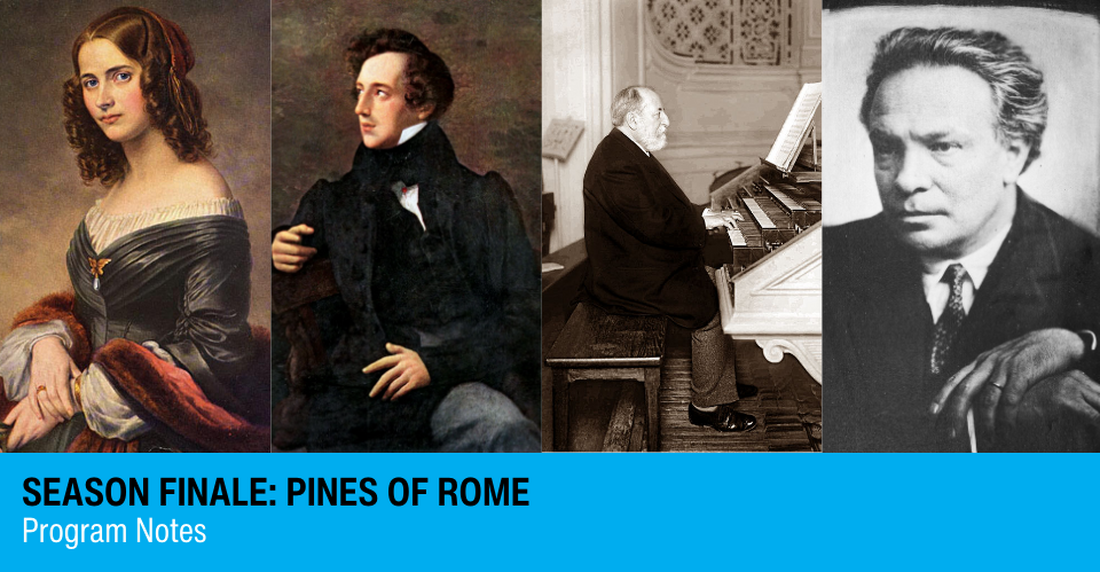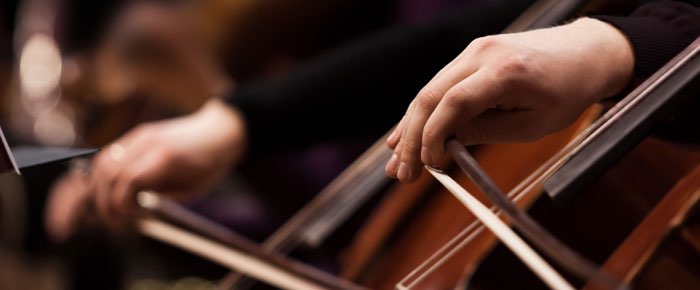30 SECOND NOTES: Fanny Mendelssohn and her younger brother, Felix, were children of a wealthy Berlin banker and given every advantage of education and social life that money could provide. Both were especially gifted in music and composed as youngsters, displaying their works at the Sunday household musicales arranged at the Mendelssohn mansion. For one of those performances around 1830, Fanny composed the accomplished Overture in C Major, but she was discouraged from any further professional activity in the field — "Music should be an accomplishment," her father declared, "and never a career for women." Felix by that time had established an international reputation as a composer, conductor and pianist, and gleaned from his constant travels such masterful compositions as the Italian Symphony of 1833. Camille Saint-Saëns was not just a gifted pianist and composer, but also an efficient musical craftsman who composed the Piano Concerto No. 2, hired the hall for its performance, got the challenging solo part into his fingers, and gave the premiere within just three weeks. The Pines of Rome by Ottorino Respighi includes his musical impressions of three of the city's most characteristic districts and ends with a thrilling evocation of a triumphant ancient Roman army mounting Capitoline Hill.
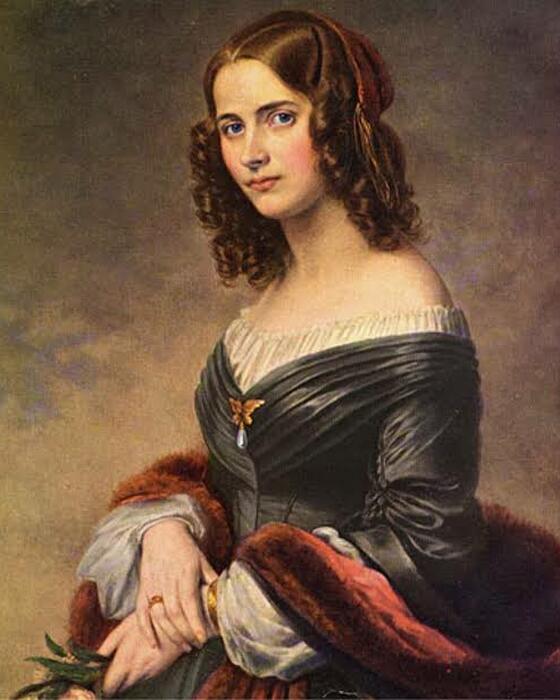
FANNY MENDELSSOHN HENSEL
- Born November 14, 1805 in Hamburg;
- died May 14, 1847 in Berlin.
OVERTURE IN C MAJOR
- First performance unknown.
- These concerts mark the first performances of this piece by the Des Moines Symphony.
(Duration: ca. 11 minutes)
It would be difficult to find a more illustrative example of the genteel social engineering of the 19th century than Fanny Mendelssohn Hensel, older sister of the renowned Felix Mendelssohn. Fanny was only six (Felix was one) when the family was forced by the Napoleonic juggernaut to abandon their native Hamburg for Berlin, but she had already been endowed with good genes and disciplined piano instruction by her talented mother, Lea, a student of the noted German theorist and pedagogue Johann Philipp Kirnberger, himself a pupil of Johann Sebastian Bach. (Lea’s sister, Sara Levy, was a gifted harpsichordist and a patron of Carl Philipp Emanuel Bach. It was through that association that a copy of Johann Sebastian Bach’s St. Matthew Passion descended to Felix, who revived the work in 1829.) Felix and Fanny were given equal privilege in the family’s cultured life — the best tutors, intensive musical study with outstanding teachers, travel, elaborate concerts for invited guests at which they displayed their talents as composers and performers, access to the finest strata of German artists and literati. Brother and sister blossomed — in an 1825 letter to Felix, Johann Wolfgang von Goethe asked his young friend to “give my regards to your equally talented sister.”
In 1825, Felix went off to university while Fanny attended Humboldt’s lectures on physical geography and Holtei’s talks on experimental physics in Berlin, but thereafter their lives — but not their loving devotion to each other and their mutual respect — went different ways. Felix became one of the most highly regarded musical figures of his day, while Fanny stayed at home, taking part in the family’s Sunday musicales but otherwise discouraged by both her brother and her father from pursuing the life of a professional musician. “You must prepare earnestly for your real calling, the only calling for a young woman — I mean the state of a housewife,” pronounced Papa Abraham. “Music should be an accomplishment, and never a career for women.” In 1829, Fanny married Wilhelm Hensel, a painter at the Prussian court, who urged her to continue composing, which she did, though with little public recognition. The Berlin publisher Schlesinger issued one of her songs in an album for voice and piano in 1837; one volume of Lieder and another of piano pieces were published in 1846. (Felix published two other of Fanny’s songs in a collection of his own works. When Queen Victoria expressed special pleasure at one of them, Felix quickly admitted that it was not his.) Fanny’s only formal concert appearance was as pianist in her brother’s G Minor Concerto in 1838. While leading a rehearsal of Felix’s Die erste Walpurgisnacht on May 14, 1847, she suffered a massive stroke and died later that day; she was 42. Felix, already ill and exhausted from punishing overwork, was prostrated by her death; he died six months later. A lovely slow theme serves as introduction. A sweeping violin passage leads to the Overture’s formal main theme, a galloping melody full of energy and joie de vivre. The woodwinds carry the music to its subsidiary subject, a succession of short string phrases that are nicely threaded into a handsome melody. The darkly colored development section rises to peaks of considerable expressive intensity before the Overture is rounded out by a full recapitulation of the earlier themes.
Score written for two flutes, two oboes, two clarinets, two bassoons, four horns, two trumpets, timpani and the usual strings.
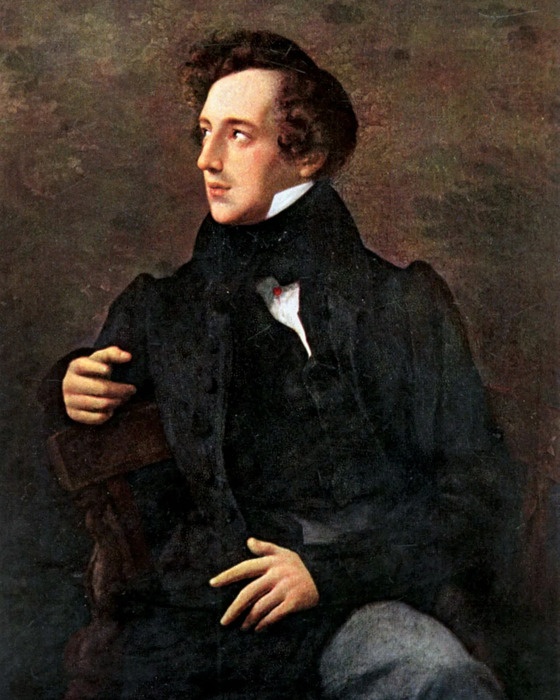
FELIX MENDELSSOHN
- Born February 3, 1809 in Hamburg;
- died November 4, 1847 in Leipzig.
SYMPHONY NO. 4 IN A MAJOR, OP. 90, "ITALIAN"
- First performed on May 13, 1833 in London, conducted by the composer.
- First performed by the Des Moines Symphony on January 25, 1942 with Frank Noyes conducting. Four subsequent performances occurred, most recently on December 1 & 2, 2012 conducted by Joseph Giunta.
(Duration: ca. 27 minutes)
When he was 21, Mendelssohn embarked on an extensive grand tour of the Continent. He met Chopin and Liszt in Paris, painted the breathtaking vistas of Switzerland, and marveled at the artistic riches (and grumbled about the inhospitable treatment by the coachmen and innkeepers) of Italy. “The land where the lemon trees blossom,” as his friend Goethe described sunny Italy, stirred him so deeply that he began a musical work there in 1831 based on his impressions of Rome, Naples and the other cities he visited. The composition of this Italian Symphony, as he always called it, caused him much difficulty, however, and he had trouble bringing all the movements to completion. “For the slow movement I have not yet found anything exactly right, and I think I must put it off for Naples,” he wrote from Rome to his sister Fanny. The spur to finish the work came in the form of a commission for a symphony from the Philharmonic Society of London that caused Mendelssohn to gather up his sketches and complete the task by 1837.
The Italian Symphony is cast in the traditional four movements. The opening movement takes an exuberant, leaping melody initiated by the violins as its principal subject and a quieter, playful strain led by the clarinets as its subsidiary theme. The intricately contrapuntal development section is largely based on a precise, staccato theme of darker emotional hue but also refers to motives from the main theme. A full recapitulation of the exposition’s materials ensues before the movement ends with a coda recalling the staccato theme from the development. The Andante may have been inspired by a religious procession Mendelssohn saw in the streets of Naples. The third movement is in the form of a minuet/scherzo whose central trio utilizes the burnished sonorities of bassoons and horns. The finale turns to a tempestuous minor key for an exuberant dance modeled on a whirling saltarello Mendelssohn heard in Rome.
Score written for pairs of woodwinds, horns and trumpets, timpani and the usual strings.
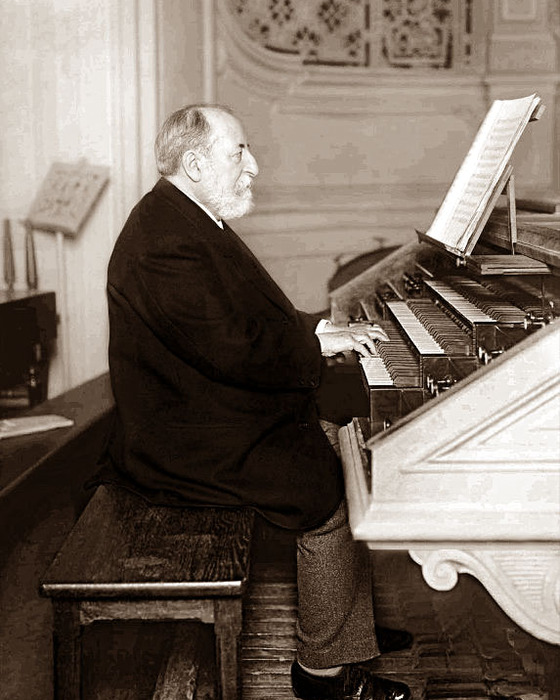
CAMILLE SAINT-SAËNS
- Born October 9, 1835 in Paris;
- died December 16, 1921 in Algiers.
PIANO CONCERTO NO. 2 IN G MINOR, OP. 22
- First performed on May 13, 1868 in Paris, with the composer as soloist and conducted by Anton Rubinstein.
- First performed by the Des Moines Symphony on May 7, 1961 with Frank Noyes conducting and Lorin Hollander as soloist. Five subsequent performances occurred, most recently on May 10 & 11, 2014 conducted by Joseph Giunta with Benjamin Grosvenor as soloist.
(Duration: ca. 24 minutes)
In addition to his gifts as a composer, Camille Saint-Saëns was also a master pianist who filled his five concertos for that instrument with imposing technical challenges and then dazzled his audiences by the ease with which he handled them. His fluency at the keyboard was paralleled by the facility with which he was able to compose, a characteristic nowhere better seen than in his Concerto No. 2, which was produced in only seventeen days. Saint-Saëns left an account of the work’s genesis: “I happened to be at a concert with the great pianist Anton Rubinstein in the Salle Pleyel when he said to me, ‘I haven’t conducted an orchestra in Paris yet. Let’s put on a concert that will give me the opportunity of taking the baton.’ ‘With pleasure,’ I answered. We asked when the Salle Pleyel would be free and we were told we should have to wait three weeks. ‘Very well,’ I said. ‘In those three weeks I will write a concerto for the occasion.’ And I wrote the G Minor Concerto which accordingly had its first performance under such distinguished patronage.”
The opening movement of the Second Piano Concerto, in slow tempo throughout, begins with a cadenza that resembles the free contrapuntal style of a Bach fantasia. The piano then announces the main theme, which Saint-Saëns admitted borrowing from a composition exercise by his student Gabriel Fauré. The development section and the cadenza are given over to a working-out of this theme. The second movement is a scherzo with two superb melodies placed in a graceful setting that owes much of its spirit and style to Mendelssohn. The quicksilver finale, derived from a vigorous Italian folk dance, the tarantella, is a virtuoso showpiece, filled with scales, trills and arpeggios executed at break-neck speed.
Score written for pairs of woodwinds, horns and trumpets, timpani, harp and strings.
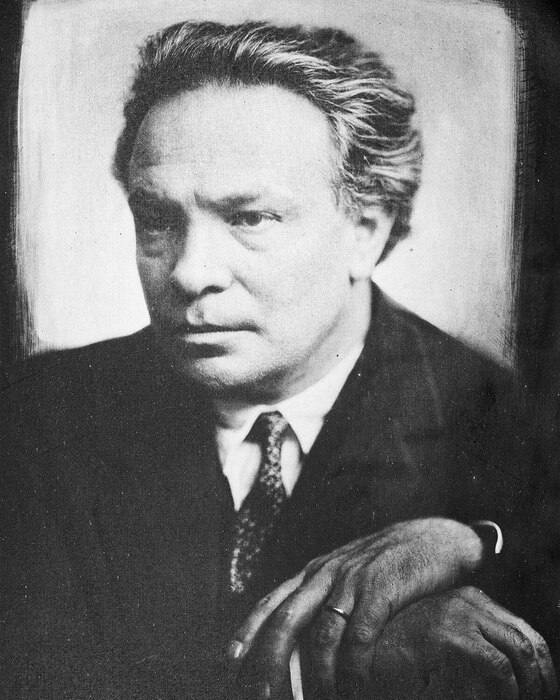
OTTORINO RESPIGHI
- Born July 9, 1879 in Bologna;
- dies April 18, 1936 in Rome.
I PINI DI ROMA ("THE PINES OF ROME")
- First performed December 14, 1924 in Rome, conducted by Bernardino Molinari.
- First performed by the Des Moines Symphony on May 3, 1959 with Frank Noyes conducting. Six subsequent performances occurred, most recently on May 18 & 19, 2019 conducted by Joseph Giunta.
(Duration: ca. 20 minutes)
Ottorino Respighi, born in 1879 into the family of a piano teacher in Bologna, was introduced to music by his father and progressed so rapidly that he began his professional training in violin, piano and composition at age thirteen at the city’s respected Liceo Musicale; his principal teacher was the school’s director, Giuseppe Martucci, then Italy’s leading composer of orchestral music. Respighi was granted a leave from the Liceo in 1900 to play as a violist with the orchestra of the St. Petersburg Opera, and he took advantage of his time in Russia to arrange what he called “a few, but for me very important” lessons with Nikolai Rimsky-Korsakov, whose brilliant orchestral technique would prove to be a lasting influence. Respighi returned to Bologna the following year to complete his degree and then went to Berlin to study violin and composition with Max Bruch. After spending another season in St. Petersburg, he settled in Bologna in 1903, earning his living as a free-lance violinist and receiving his earliest notice as a composer. He was back in Berlin in 1908, teaching piano at a private school there and promoting his work so effectively that the renowned conductor Arthur Nikisch included his transcription of Monteverdi’s Lamento d’Arianna on a Berlin Philharmonic concert. Respighi went home to Bologna in 1909 and four years later was appointed to the faculty of Rome’s Santa Cecilia Academy. He found his first great success, and his musical voice, with the opulent tone poem The Fountains of Rome of 1916. He was appointed director of the Academy in 1923 but found the administrative duties too intrusive on his creative work and resigned from the position three years later, though he did continue teaching privately for several years. He toured internationally during the following years to conduct and occasionally appear as piano soloist in his works, but his demanding career took a toll on his health and a heart condition was diagnosed in 1931. Respighi died of a heart attack in Rome on April 18, 1936; he was 56.
The Pines of Rome is the second work of Respighi’s trilogy on Roman subjects. The first was The Fountains of Rome of 1916; the last, Roman Festivals, dates from 1928. These compositions depict various aspects of the city through Respighi’s musical impressions. He wrote that The Pines of Rome “uses nature as a point of departure, in order to recall memories and visions. The centuries-old trees that dominate so characteristically the Roman landscape become testimony for the principal events in Roman life. 1. The Pines of the Villa Borghese. Children are at play in the pine grove of the Villa Borghese, dancing the Italian equivalent of Ring around the Rosy; mimicking marching soldiers and battles; twittering and shrieking like swallows at evening; and they disappear. Suddenly the scene changes to ... 2. The Pines near a Catacomb. We see the shadows of the pines, which overhang the entrance of a catacomb. From the depths rises a chant which re-echoes solemnly, like a hymn, and is then mysteriously silenced. 3. The Pines of the Janiculum. There is a thrill in the air. The full moon reveals the profile of the pines of Gianicolo’s Hill. A nightingale sings. 4. The Pines of the Appian Way. Misty dawn on the Appian Way. The tragic country is guarded by solitary pines. Indistinctly, incessantly, the rhythm of innumerable steps. To the poet’s fantasy appears a vision of past glories; trumpets blare, and the army of the Consul advances brilliantly in the grandeur of a newly risen sun toward the Sacred Way, mounting in triumph the Capitoline Hill.”
Score written for piccolo, three flutes, two oboes, English horn, two clarinets, bass clarinet, two bassoons, contrabassoon, four horns, three trumpets, three trombones, tuba, timpani, bass drum, cymbals, glockenspiel, tambourine, triangle, ratchet, tam-tam, celesta, piano, organ, six off-stage “bucinae” (ancient Roman war trumpets ad lib, playable on flugelhorns), the usual strings and a recorded song of a nightingale.
